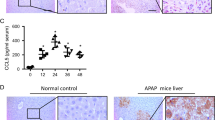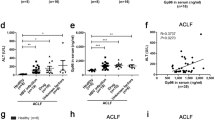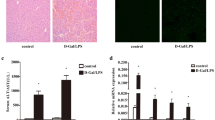Abstract
Growing evidence demonstrates that cyclic GMP-AMP synthase (cGAS), as a cytosolic DNA sensor, is essential for activating innate immunity and regulating inflammatory response against cellular damage. However, its role in immune-mediated hepatitis remains unclear. Here by challenging the cGAS knockout (KO) and their littermate wide-type (WT) mice with intravenous ConA injection to induce acute immune-mediated liver injury, we found that lack of cGAS drastically aggravated liver damage post ConA treatment for 24 h, reflected by increased alanine aminotransferase (ALT) and aspartate aminotransferase (AST) levels and amplified hepatic necrosis. The number of apoptotic hepatocytes was also significantly increased in the KO mice. RNA-sequencing analysis revealed that leukocyte chemotaxis and migration-related genes were remarkably upregulated in the KO livers. Consistently, immunofluorescence assays illustrated that the infiltrating F4/80-positive macrophages, Ly6G-positive neutrophils, and CD3-positive T cells were all significantly increased in the KO liver sections. The hepatic expression of the pro-inflammatory genes was elevated as well. Supporting the in vivo findings, the knockdown of cGAS in cultured macrophages showed promoted migration potential and enhanced pro-inflammatory gene expression. These results collectively demonstrated that deletion of cGAS could aggravate ConA-induced acute liver injury, at least at the 24-h time point, and its mechanism might be related to facilitating leukocyte chemotaxis and promoting liver inflammatory response.






Similar content being viewed by others
DATA AVAILABILITY
The data sets used and/or analyzed during the current study are available from the corresponding author upon reasonable request.
MATERIALS AVAILABILITY
The data sets used and/or analyzed during the current study are available from the corresponding author upon reasonable request.
References
Jenne, C.N., and P. Kubes. 2013. Immune surveillance by the liver. Nature Immunology 14 (10): 996–1006. https://doi.org/10.1038/ni.2691.
Eksteen, B., S.C. Afford, S.J. Wigmore, A.P. Holt, and D.H. Adams. 2007. Immune-mediated liver injury. Seminars in Liver Disease 27 (4): 351–366. https://doi.org/10.1055/s-2007-991512.
Khan, H.A., M.Z. Ahmad, J.A. Khan, and M.I. Arshad. 2017. Crosstalk of liver immune cells and cell death mechanisms in different murine models of liver injury and its clinical relevance. Hepatobiliary & Pancreatic Diseases International 16 (3): 245–256. https://doi.org/10.1016/s1499-3872(17)60014-6.
Sun, L., J. Wu, F. Du, X. Chen, and Z.J. Chen. 2013. Cyclic GMP-AMP synthase is a cytosolic DNA sensor that activates the type I interferon pathway. Science 339 (6121): 786–791. https://doi.org/10.1126/science.1232458.
Li, X.D., J. Wu, D. Gao, H. Wang, L. Sun, and Z.J. Chen. 2013. Pivotal roles of cGAS-cGAMP signaling in antiviral defense and immune adjuvant effects. Science 341 (6152): 1390–1394. https://doi.org/10.1126/science.1244040.
Ablasser, A. and Z.J. Chen. 2019. cGAS in action: expanding roles in immunity and inflammation. Science. 363(6431). https://doi.org/10.1126/science.aat8657.
Ke, X., T. Hu, and M. Jiang. 2022. cGAS-STING signaling pathway in gastrointestinal inflammatory disease and cancers. FASEB Journal 36(1): e22029. https://doi.org/10.1096/fj.202101199R.
Liao, W., C. Du, and J. Wang. 2020. The cGAS-STING pathway in hematopoiesis and its physiopathological significance. Frontiers in Immunology 11: 573915. https://doi.org/10.3389/fimmu.2020.573915.
Wang, H., S. Hu, X. Chen, H. Shi, C. Chen, L. Sun, et al. 2017. cGAS is essential for the antitumor effect of immune checkpoint blockade. Proceedings of the National Academy of Sciences of the United States of America. 114 (7): 1637–1642. https://doi.org/10.1073/pnas.1621363114.
Xu, D., Y. Tian, Q. Xia, and B. Ke. 2021. The cGAS-STING pathway: novel perspectives in liver diseases. Frontiers in Immunology 12: 682736. https://doi.org/10.3389/fimmu.2021.682736.
Tiegs, G., J. Hentschel, and A. Wendel. 1992. A T cell-dependent experimental liver injury in mice inducible by concanavalin A. Journal of Clinical Investigation 90 (1): 196–203. https://doi.org/10.1172/jci115836.
Heymann, F., K. Hamesch, R. Weiskirchen, and F. Tacke. 2015. The concanavalin A model of acute hepatitis in mice. LabAnimal 49 (1 Suppl): 12–20. https://doi.org/10.1177/0023677215572841.
Xu, C.,C. Zhang, J. Ji, C. Wang, J. Yang, B. Geng, et al. 2018. CD36 deficiency attenuates immune-mediated hepatitis in mice by modulating the proapoptotic effects of CXC chemokine ligand 10. Hepatology 67 (5): 1943–1955. https://doi.org/10.1002/hep.29716.
Sun, Z., Q. Wang, L. Sun, M. Wu, S. Li, H. Hua, et al. 2022. Acetaminophen-induced reduction of NIMA-related kinase 7 expression exacerbates acute liver injury. JHEP Reports 4(10): 100545. https://doi.org/10.1016/j.jhepr.2022.100545.
Marra, F., and F. Tacke. 2014. Roles for chemokines in liver disease. Gastroenterology 147 (3): 577-594.e1. https://doi.org/10.1053/j.gastro.2014.06.043.
Marra, F. 2002. Chemokines in liver inflammation and fibrosis. Frontiers in Bioscience 7: d1899–d1914. https://doi.org/10.2741/a887.
Erhardt, A., and G. Tiegs. 2010. Tolerance induction in response to liver inflammation. Digestive Diseases 28 (1): 86–92. https://doi.org/10.1159/000282069.
Afonso, M.B., P.M. Rodrigues, M. Mateus-Pinheiro, A.L. Simão, M.M. Gaspar, A. Majdi,et al. 2021. RIPK3 acts as a lipid metabolism regulator contributing to inflammation and carcinogenesis in non-alcoholic fatty liver disease. Gut 70 (12): 2359–2372. https://doi.org/10.1136/gutjnl-2020-321767.
Islam, T. and M.B. Afonso. 2022. The role of RIPK3 in liver mitochondria bioenergetics and function. European Journal of Clinical Investigation 52(3): e13648. https://doi.org/10.1111/eci.13648.
Luther, J., S. Khan, M.K. Gala, D. Kedrin, G. Sridharan, R.P. Goodman, et al. 2020. Hepatic gap junctions amplify alcohol liver injury by propagating cGAS-mediated IRF3 activation. Proceedings of the National Academy of Sciences of the United States of America 117 (21): 11667–11673. https://doi.org/10.1073/pnas.1911870117.
Du, S., G. Chen, B. Yuan, Y. Hu, P. Yang, Y. Chen, et al. 2021. DNA sensing and associated type 1 interferon signaling contributes to progression of radiation-induced liver injury. Cellular & Molecular Immunology 18 (7): 1718–1728. https://doi.org/10.1038/s41423-020-0395-x.
Lei, Z. and M. Deng. 2018. cGAS-mediated autophagy protects the liver from ischemia-reperfusion injury independently of STING. American Journal of Physiology-Gastrointestinal and Liver Physiology 314(6): G655-g667. https://doi.org/10.1152/ajpgi.00326.2017.
He, J., R. Hao, D. Liu, X. Liu, S. Wu, S. Guo, et al. 2016. Inhibition of hepatitis B virus replication by activation of the cGAS-STING pathway. Journal of General Virology 97 (12): 3368–3378. https://doi.org/10.1099/jgv.0.000647.
Lauterbach-Rivière, L., M. Bergez, S. Mönch, B. Qu, M. Riess, F.W.R. Vondran, et al. 2020. Hepatitis B virus DNA is a substrate for the cGAS/STING pathway but is not sensed in infected hepatocytes. Viruses 12(6). https://doi.org/10.3390/v12060592.
Yi, G., Y. Wen, C. Shu, Q. Han, K.V. Konan, P. Li, et al. 2016. Hepatitis C virus NS4B can suppress STING accumulation to evade innate immune responses. Journal of Virology 90 (1): 254–265. https://doi.org/10.1128/jvi.01720-15.
Ding, Q., X. Cao, J. Lu, B. Huang, Y.J. Liu, N. Kato, et al. 2013. Hepatitis C virus NS4B blocks the interaction of STING and TBK1 to evade host innate immunity. Journal of Hepatology 59 (1): 52–58. https://doi.org/10.1016/j.jhep.2013.03.019.
Jiang, M., P. Chen, L. Wang, W. Li, B. Chen, Y. Liu, et al. 2020. cGAS-STING, an important pathway in cancer immunotherapy. Journal of Hematology & Oncology 13 (1): 81. https://doi.org/10.1186/s13045-020-00916-z.
Shi, X., Y. Yang, W. Zhang, J. Wang, D. Xiao, H. Ren, et al. 2022. FLASH X-ray spares intestinal crypts from pyroptosis initiated by cGAS-STING activation upon radioimmunotherapy. Proceedings of the National Academy of Sciences of the United States of America 119(43): e2208506119. https://doi.org/10.1073/pnas.2208506119.
McGill, M.R., C.D. Williams, Y. Xie, A. Ramachandran, and H. Jaeschke. 2012. Acetaminophen-induced liver injury in rats and mice: Comparison of protein adducts, mitochondrial dysfunction, and oxidative stress in the mechanism of toxicity. Toxicology and Applied Pharmacology 264 (3): 387–394. https://doi.org/10.1016/j.taap.2012.08.015.
Karlmark, K.R., R. Weiskirchen, H.W. Zimmermann, N. Gassler, F. Ginhoux, C. Weber, et al. 2009. Hepatic recruitment of the inflammatory Gr1+ monocyte subset upon liver injury promotes hepatic fibrosis. Hepatology 50 (1): 261–274. https://doi.org/10.1002/hep.22950.
Jaeckel, E., M. Hardtke-Wolenski, and K. Fischer. 2011. The benefit of animal models for autoimmune hepatitis. Best Practice & Research Clinical Gastroenterology 25 (6): 643–651. https://doi.org/10.1016/j.bpg.2011.10.006.
Ishikawa, H., Z. Ma, and G.N. Barber. 2009. STING regulates intracellular DNA-mediated, type I interferon-dependent innate immunity. Nature 461 (7265): 788–792. https://doi.org/10.1038/nature08476.
Barnett, K.C., J.M. Coronas-Serna, W. Zhou, M.J. Ernandes, A. Cao, P.J. Kranzusch, et al. 2019. Phosphoinositide interactions position cGAS at the plasma membrane to ensure efficient distinction between self- and viral DNA. Cell 176 (6): 1432-1446.e11. https://doi.org/10.1016/j.cell.2019.01.049.
Hopfner, K.P., and V. Hornung. 2020. Molecular mechanisms and cellular functions of cGAS-STING signalling. Nature Reviews Molecular Cell Biology 21 (9): 501–521. https://doi.org/10.1038/s41580-020-0244-x.
Jiang, H., X. Xue, and S. Panda. 2019. Chromatin-bound cGAS is an inhibitor of DNA repair and hence accelerates genome destabilization and cell death. EMBO Journal 38(21): e102718. https://doi.org/10.15252/embj.2019102718.
Gentili, M., X. Lahaye, F. Nadalin, G.P.F. Nader, E. Puig Lombardi, S. Herve, et al. 2019. The N-terminal domain of cGAS determines preferential association with centromeric DNA and innate immune activation in the nucleus. Cell Reports 26 (9): 2377-2393.e13. https://doi.org/10.1016/j.celrep.2019.01.105.
Volkman, H.E., S. Cambier, E.E. Gray, and D.B. Stetson. 2019. Tight nuclear tethering of cGAS is essential for preventing autoreactivity. Elife 8. https://doi.org/10.7554/eLife.47491.
Sun, H., Y. Huang, S. Mei, F. Xu, X. Liu, F. Zhao, et al. 2021. A nuclear export signal is required for cGAS to sense cytosolic DNA. Cell Reports 34(1): 108586. https://doi.org/10.1016/j.celrep.2020.108586.
Liu, H., H. Zhang, X. Wu, D. Ma, J. Wu, L. Wang, et al. 2018. Nuclear cGAS suppresses DNA repair and promotes tumorigenesis. Nature 563 (7729): 131–136. https://doi.org/10.1038/s41586-018-0629-6.
Chen, H. and H. Chen. 2020. cGAS suppresses genomic instability as a decelerator of replication forks. Science Advances 6(42). https://doi.org/10.1126/sciadv.abb8941.
Li, X., X. Li, C. Xie, S. Cai, M. Li, H. Jin, et al. 2022. cGAS guards against chromosome end-to-end fusions during mitosis and facilitates replicative senescence. Protein & Cell 13 (1): 47–64. https://doi.org/10.1007/s13238-021-00879-y.
Thomsen, M.K., R. Nandakumar, D. Stadler, A. Malo, R.M. Valls, F. Wang, et al. 2016. Lack of immunological DNA sensing in hepatocytes facilitates hepatitis B virus infection. Hepatology 64 (3): 746–759. https://doi.org/10.1002/hep.28685.
Iracheta-Vellve, A., J. Petrasek, B. Gyongyosi, A. Satishchandran, P. Lowe, K. Kodys, et al. 2016. Endoplasmic reticulum stress-induced hepatocellular death pathways mediate liver injury and fibrosis via stimulator of interferon genes. Journal of Biological Chemistry 291 (52): 26794–26805. https://doi.org/10.1074/jbc.M116.736991.
Cho, C.S., H.W. Park, A. Ho, I.A. Semple, B. Kim, I. Jang, et al. 2018. Lipotoxicity induces hepatic protein inclusions through TANK binding kinase 1-mediated p62/sequestosome 1 phosphorylation. Hepatology 68 (4): 1331–1346. https://doi.org/10.1002/hep.29742.
Burleigh, K. and J.H. Maltbaek. 2020. Human DNA-PK activates a STING-independent DNA sensing pathway. Science Immunology 5(43). https://doi.org/10.1126/sciimmunol.aba4219.
Chu, T.T., and X. Tu. 2021. Tonic prime-boost of STING signalling mediates Niemann-Pick disease type C. Nature 596 (7873): 570–575. https://doi.org/10.1038/s41586-021-03762-2.
Funding
This research was funded by the National Natural Science Foundation of China (32071157 and 31900142).
Author information
Authors and Affiliations
Contributions
Performing experiments: J.L., Z.L., and M.G.; writing—original draft preparation: S.J. and J.L.; writing—review and editing: G.Y. and L.C.; supervision: L.C.; funding acquisition: L.C. and S.J. All authors read and approved the final manuscript.
Corresponding author
Ethics declarations
Ethics Approval
All animal experiments were conducted in accordance with the guidelines approved by the Dalian Medical University Animal Care and Use Committee.
Conflict of Interest
The authors declare no competing interests.
Additional information
Publisher's Note
Springer Nature remains neutral with regard to jurisdictional claims in published maps and institutional affiliations.
Rights and permissions
Springer Nature or its licensor (e.g. a society or other partner) holds exclusive rights to this article under a publishing agreement with the author(s) or other rightsholder(s); author self-archiving of the accepted manuscript version of this article is solely governed by the terms of such publishing agreement and applicable law.
About this article
Cite this article
Liu, J., Ji, S., Liu, Z. et al. Deletion of Cyclic GMP-AMP Synthase Aggravates Concanavalin A-Induced Acute Hepatic Injury by Facilitating Leukocyte Chemotaxis. Inflammation 46, 1118–1130 (2023). https://doi.org/10.1007/s10753-023-01798-2
Received:
Revised:
Accepted:
Published:
Issue Date:
DOI: https://doi.org/10.1007/s10753-023-01798-2




